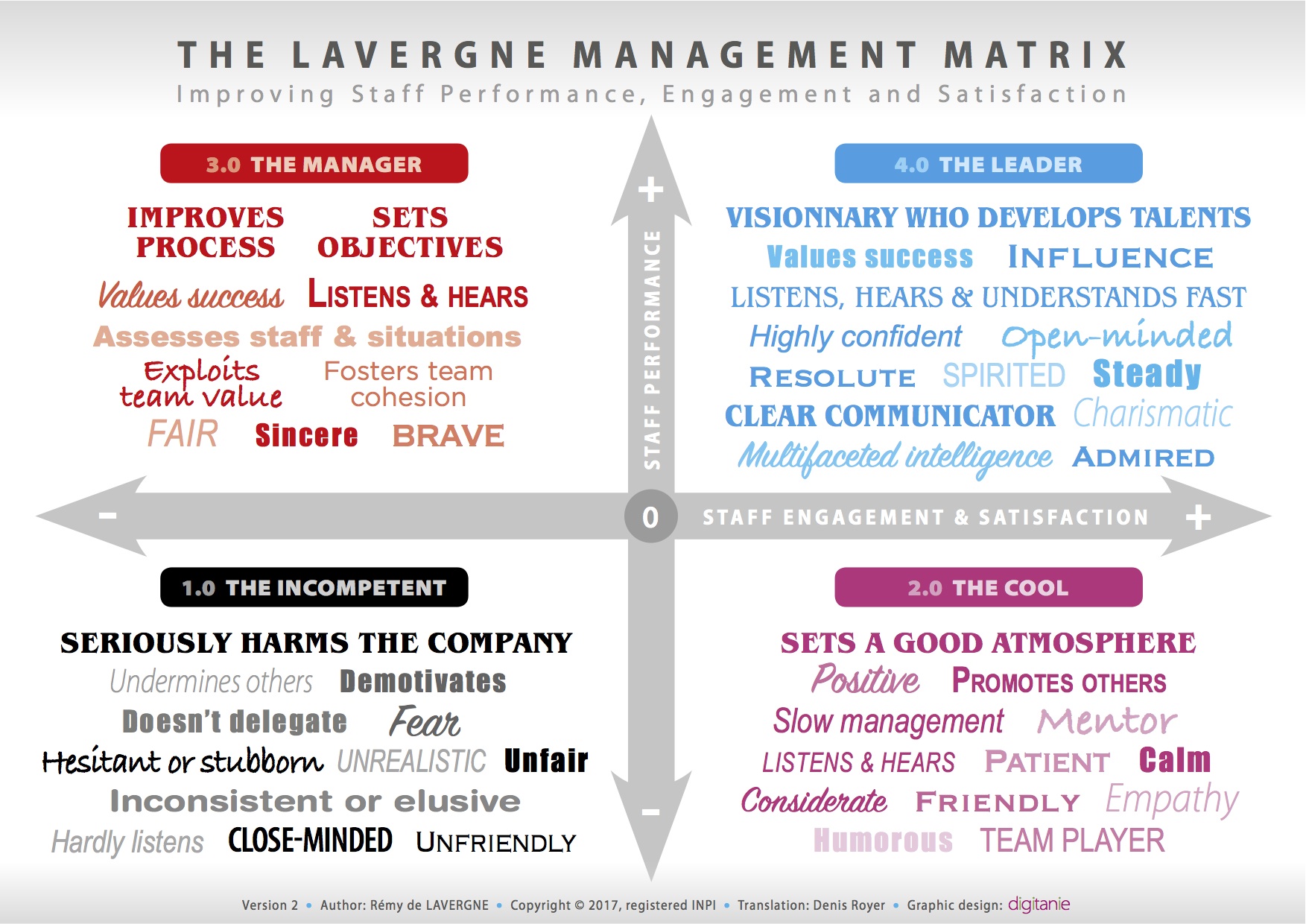LAVERGNE Management Matrix Operating Instructions: Benevolent Leadership
I created the Lavergne Management Matrix to make it possible to share and discuss ‘Benevolent Leadership’.
The managerial aptitude of a person can be evaluated according to two criteria:
- The satisfaction of her/her employees (whether trending down, stable, up)
- The performance of his/her employees (whether trending down, stable, up)
Before implementing the Matrix, it is important to begin by increasing employee satisfaction. I advocate going to meet with each individual face-to-face, and speaking as two peers. It is critical to listen deeply, sincerely, and benevolently to each person to gain a true understanding of what is important to them, including their professional history, current situation, current and potential capabilities, and career aspirations.
The satisfaction of an employee is often multifaceted, for example:
- Financial: salary, bonuses and benefits.
- Statutory: title, company car, and driver
- Intellectual: human interests and sense of work
It is very important to listen to people and truly hear them in order to optimize the virtuous triangle, which combines:
- The needs of the company,
- The aspirations (of the collaborators), and
- The Current and future capacities (of collaborators).
The two questions to be asked to assess the managerial qualities of a person who leads a team are:
- Has the satisfaction of his/her employees increased since taking office?
- Has the performance of his/her employees increased since taking office?
Then we have to ask ourselves about the causal links between:
- On the one hand, the evolution of employee satisfaction and team/individual performance,
- And on the other hand the actions taken by the person leading the team.
A person who is able to improve the satisfaction and performance of his collaborators at the same time is a ‘Benevolent Leader’ (Matrix quadrant 4.0). Few people are destined to become Benevolent Leaders, and even they achieve this by having exceptional capacities and strong willpower.

Very often, a Benevolent Leader:
- Is visionary and shares his/her vision in (and sometimes outside of) the company.
- Develops talents (those of his/her collaborators and sometimes of supply partners).
- Listens, hears, and understands quickly.
- Is open-minded.
- Has charisma.
- Enjoys a great deal of confidence from his/her colleagues.
- Is vigorous.
- Is resolute.
- Is endowed with multiform intelligence (e.g. Cartesian, emotional).
- Is steady (i.e. constant).
- Is a clear communicator.
- Is admired.
- Has a great ability to influence others.
- And is success-driven.
When a company identifies a Benevolent Leader on staff, they must thoroughly analyze his/her methods and try to implement them in other functions and departments whenever possible. The company must also do everything possible to keep the leader, especially deterring him/her from going to the competition. To do this, executive leaders must have regular contact with the Benevolent Leader: speaking, listening to, and inquiring about medium and long-term aspirations. It is also important to place these unique people in jobs that fully leverage their capabilities and potential.
The other three quadrants of the Management Matrix are Manager, Cool, and Incompetent. In all of these cases, the company should understand each person’s positive contributions to employee performance and satisfaction and share those learnings internally.
3.0: The Manager contributes to the improvement of employee performance in an efficient way but without increasing employee satisfaction. This person must be trained to continue improving employee performance while also improving their satisfaction.
2.0: The Cool improves satisfaction of his/her employees without generating any improvement in their performance. This positively contributes to the atmosphere and culture of the company. This person must be trained to continue improving employee satisfaction while also improving their performance.
1.0: The Incompetent allows a decline in employee performance and also the deterioration of their satisfaction. This seriously hurts the business. The company must identify this circumstance as soon as possible, and either provide the necessary training to improve his/her leadership abilities or remove all or part of their managerial responsibilities.
For more information about the Matrix (which is available in English, Spanish, French, Portuguese, Russian, Polish, Catalan, Hindi, Arabic, Ukrainian, and Turkish) or to request permission to use it at your school or company, contact me.
When you subscribe to the blog, we will send you an e-mail when there are new updates on the site so you wouldn't miss them.
